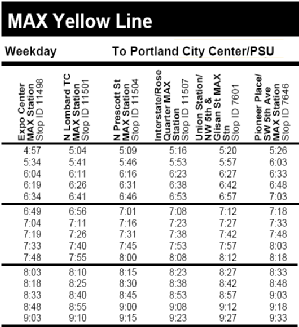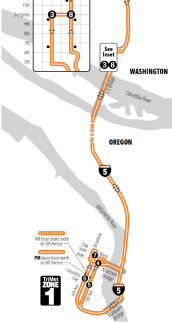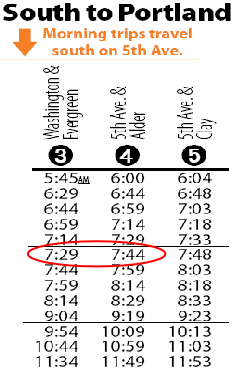
Portland is a PR machine for light rail & streetcar
Here are Some Facts About Portland Oregon
“It must always be remembered how cost-effectiveness works in the public sector: the cost IS the benefit.” - author unknown
References
Draft Environmental Statement, page S-26
This is from page S-26 of the Draft Draft Environmental Statement available here.
Draft Environmental Statement, page S-4
This is from page S-4 of the Draft Draft Environmental Statement available here.
Approximately 81,000 people make round trips across the river:
EXISTING: DAILY TRAFFIC LEVELS
Average daily traffic volumes represent the average 24-hour weekday traffic on a roadway segment. The I-5 bridges currently carry 135,000 vehicles each day.
At an average of 1.2 people per vehicle, this is 162,000 people crossing daily.
Divide this by two to get the number of people making round trips: 81,000.
Approximately 30 people make round trips on foot each day:
Approximately 150 people make round trips on bikes each day:
From CRC DEIS, Page 3-12:
a substantial number of pedestrians and bicyclists use the existing crossing facilities. Year 2007 (September) 14-hour weekday counts (from 6 a.m. until 8 p.m.) showed about 60 pedestrians and 300 bicyclists using the crossing. About twice as many bicyclists use the western bridge’s sidewalk, primarily because it connects more directly with bicycle routes to the north and south. About 60 percent of the pedestrians crossing the Columbia River use the western sidewalk.
A multi-use pathway is located on the east side of the I-5 crossing of North Portland Harbor. The 14-hour counts showed about 30 pedestrians and 350 bicyclists using the pathway. For comparative purposes, pedestrian and bicycle counts were also conducted on the I-205 crossing. The 14-hour counts showed about 10 pedestrians and 190 bicyclists using the I-205 crossing’s multi-use pathway, which meets current standards
We chose to use the 60 pedestrians and 300 bicycle numbers as they appear to be those actually crossing the Interstate Bridge, while the 30 & 350 numbers are for the North Portland Harbor crossing
Approximately 1650 people, per day make round trips across the bridge on transit.
From CRC DEIS, Page 3-18:
About 3,300 weekday daily transit passenger trips across the Columbia River used the I-5 corridor in 2006.1 This includes approximately 1,400 trips on the four C-TRAN express bus routes and 1,900 local bus trips.
Of course these people make round trips, so 3300 trips is the result of 1650 people making round trips.
Light rail IS NOT REQUIRED by any government agency.
“High Capacity Transit” IS NOT REQUIRED by any government agency.
From minutes of the RTC board meeting, June 2, 2009:
Steve Stuart said it is not legally true that you must have a multi modal project to get approval or funding from Federal Highway Administration. There has been a lot who have said it because they believe that functionally, it would be necessary to have a project. Bicycle and Pedestrian facilities are legally required for transportation improvements.
There are no documents in our possession that claim that the federal government requires light rail as a part of the CRC project.
Email from the CRC:
In response to your request for records dated January 31, 2010,:
" Please provide copies of all documents in your posession that claim that the federal government
requires light rail as part of the CRC project. "
Please find the answers to the your questions below:
There are no documents in our possession that claim that the federal government requires light rail as a
part of the CRC project. The Columbia River Crossing project worked with the public, the CRC Task
Force, local agencies and elected officials to develop the problem definition and the purpose and need
statement. The purpose and need statement received concurrence from the Federal Transit
Administration (FTA) and the Federal Highway Administration (FHWA) and identifies six problems which
the CRC project will address: growing travel demand and congestion; impaired freight movement;
limited public transportation operation, connectivity and reliability; safety and vulnerability to collisions;
substandard pedestrian and bicycle facilities; and, seismic vulnerability.
To address the problem of limited public transportation operation, CRC analyzed several transit modes,
including light rail, local buses, express buses and bus rapid transit in consultation with the public, the
task force and local agencies and elected officials. Transit alternatives analyzed in the Draft
Environmental Impact Statement (EIS) were identified through this public process and received
concurrence by FTA and FHWA. Technical findings in the Draft EIS show that light rail would provide
faster and more direct access to key destinations, which would help attract more daily transit riders than
bus rapid transit. The project’s local partner agencies considered the technical findings, the Task Force
recommendation and about 1,600 public comments when they selected a replacement I-5 bridge with
light rail as the CRC’s Locally Preferred Alternative in summer 2008. These project elements were
selected because they could best address the transportation problems on I-5 identified in the purpose
and need statement.
With this letter, your request for records dated January 31,2010 is complete.
If you have any further questions you may contact me at 360.816.2188.
Sincerely,
Tonja L. Gleason C.P.A.
Public Disclosure Coordinator
Columbia River Crossing Project
700 Washington Ave. STE 300,
Vancouver, Washington 98660
360.816.2188
www.columbiarivercrossing.org
Both of the bridges are structurally sufficient and meet all of the requirements."
From: minutes of the October 20 & 21 2004 Washington Transportation Commission, pg 17 (no longer on line) Archived copy here
High transit usage projections rely on Vancouver population density increasing due to development caused by light rail. (Verbal communication at a June 2009 CRC open house.)
Federal maximum money available = $ 600 million
CRC DEIS, Page 4-13:
The preliminary financial scenarios target a cumulative total of $400-$600 million from congressionally and administratively approved federal highway discretionary grants throughout project development and construction.
Financial Capacity of Toll Bonds, exhibit 4.3-2, Ch 4 CRC DEIS


C-Tran Bus #105 Salmon Creek Express
MAX Yellow line
Bus Travel Time from Vancouver to downtown Portland, 7:10 am - 11:34 am :
15 min


MAX travel time from Vancouver to downtown Portland, 7:33 am - 11:33 am:
33.6 min *
* add 3.6 min to Expo time to get Vancouver time. Source of 3.6 min: CRC Transit Technicial Report Exhibit 20

Afternoon, Northbound is still much faster than MAX, at 22 min

15 min
30 min
Is The Bus Really that fast?
To check, we emailed C-Tran this on November 11, 2009:
Can I count on the travel times listed for your lines to/from Portland (#65, 105 & 164) being accurate during rush hour? Or do the buses generally arrive later than the listed times? Thanks JK
and got this answer (bold added):
Mr. Karlock,
Thank you for your e-mail and interest in riding C-Tran. Our commuter buses along with non-commuter buses do their best to keep their given schedules, they are however subject to traffic issues. Generally, they are on schedule but may at times run into unavoidable difficulties particularly on Friday afternoons.
Hope this helps answer your question.
Sincerely,
Pam F
Passenger Service Rep
MAX = 34 min
C-Tran Bus = 15 min
| Bribery |
| Cheaper & Better Transit |
| EuroTranistShareLoss |
| Elderly Travel |
| GM & The Streetcar |
| Commute Time Chart |
| Top 10 Bus |
| Clackamas Public Safety |
| transit_congestion |
| McLoughlin Plan |
| CRC_Planning |
| Zoneing Increases Cost, Hurts Economy |
| High Rise |